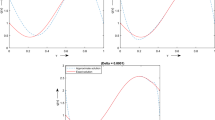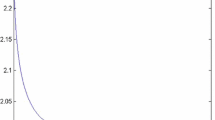Abstract
In this paper, we consider a linear equation Ax=u. A is an operator with an unbounded inverse in a Hilbert space. The right side u does not belong to the range of A. Obviously, a solution in classical sense does not exist and A −1 u does not have a sense.
To solve this problem arising from many experimental fields of science, where the second member u stems from measurements, we propose a recurrent procedure which converges almost completely and in quadratic mean to L-pseudo-solution and for which we build up a confidence interval. To check the validity of our results, a numerical example which is standard in rheology is proposed.
Similar content being viewed by others
References
Avril S, Bonnet M, Bretelle S, Grediac M, Hild F, Ienny P, Latourte F, Lemosse D, Pagano S, Pagnacco E, Pierron F (2008) Overview of identification methods of mechanical parameters based on full-field measurements. Exp Mech 48:381–402
Bonnet M, Constantinescu A (2005) Inverse problems in elasticity. Inverse Probl 21:1–50
Bui HD (1994) Inverse problems in the mechanics of materials: an introduction. CRC Press, Boca Raton
Honerkamp J, Wesse J (1990) Tikhonov regularization method for ill-posed problems: a comparison of different methods for the determination of the regularization parameter. Contin Mech Thermodyn 2:17–30
Tikhonov AN (1963) Solution of incorrectly formulated problems and regularization method. Soviet Math Dokl 1035–1038
Tikhonov AN, Arsenine VY (1977) Solutions of ill-posed problems. Wiley, New York
Picard E (1910) Sur un théorème général relatif aux équations intégrales de première espèce et sur quelques problèmes de physique mathématique. Rend Circ Mat Palermo 29:79–97
Phillips DL (1962) A technique for the numerical solution of certain integral equations of the first kind. J Assoc Comput Mach 9:84–97
Landweber L (1951) An iteration formula for Fredholm integral equations of the first kind. Am J Math 73:615–624
Ivanov VK (1962) On linear problems that are not well-posed. Dokl Akad Nauk SSSR 145(2):270–272 (in Russian)
Arcangeli R (1966) Pseudo-solution de l’équation Ax=y. C R Acad Sci 263(8):282–285
Dahmani A, Bouhmila F (2006) Consistency of Landweber algorithm in an ill-posed problem with random data. C R Sci Paris, Ser I 343:487–491
Bissantz N, Honage T, Munk A (2004) Consistency and rate of convergence of non linear Tikhonov regularization with random noise. Inverse Probl 20:1773–1789
Bondarev V, Dahmani A (1990) Stochastic approximation in ill posed problems with random errors. Avtom Telemeh 1990(5):54–63. Translation in: Bondarev BV, Dahmani A (1990) Autom Remote Control 45(51):615–623 (Part 1)
Cardot H (2002) Spatially adaptive splines for statistical linear inverse problems. J Multivar Anal 81:100–119
Cavalier L (2006) Inverse problems with non compact operators. J Stat Plan Inference 136:390–400
Kaipio J, Somersalo E (2004) Computational and statistical methods for inverse problems. Springer, New York
Morozov VA (1969) Pseudo-solutions. USSR Comput Math Math Phys 9(6):196–203
Honerkamp J (1989) Ill-posed problems in rheology. Rheol Acta 28(5):363–371
Lee S, Knauss WG (2000) A note on the determination of relaxation and creep data from ramp tests. Mech Time-Depend Mater 4:1–7
Meissner J (1978) Combined constant strain rate and stress relaxation test for linear vicoelastic studies. J Polym Sci, Polym Phys Ed 16:915–919
Sorvari J, Malinen M (2006) Determination of relaxation modulus of linearly viscoelastic material. Mech Time-Depend Mater. doi:10.1007/s11043-006-9011-4
Mead DW (1994) Numerical interconversion of linear viscoelastic material functions. J Rheol 38(6):1769–1794
Sorvari J, Malinen M (2007) Numerical interconversion between linear viscoelastic material functions with regularization. Int J Solids Struct 44:1291–1303
Tschoegl NW (1989) The phenomenological theory of linear viscoelastic behaviour. Springer, Berlin
Bechir H, Idjeri M (2011) Computation of the relaxation and creep functions of elastomers from harmonic shear modulus. Mech Time-Depend Mater 15:119–138
Author information
Authors and Affiliations
Corresponding author
Electronic Supplementary Material
Below is the link to the electronic supplementary material.
Rights and permissions
About this article
Cite this article
Dahmani, A., Zerouati, H. & Bouhmila, F. The L-pseudo-solution using stochastic algorithm of Landweber. Meccanica 47, 1935–1943 (2012). https://doi.org/10.1007/s11012-012-9565-y
Received:
Accepted:
Published:
Issue Date:
DOI: https://doi.org/10.1007/s11012-012-9565-y




